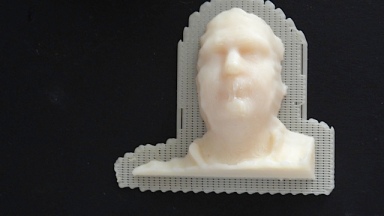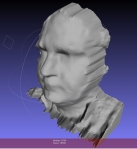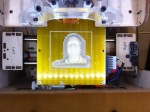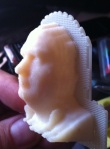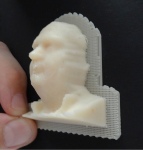So, when you do this stuff I do (whatever is it, now they call it being a ‘maker’) you think you are alone in this part of the world: you can read what other people do on the internet, most in the USA and Australia, some in Europe… but they never seem to be here in Spain. You wish Scotty could beam you across the Atlantic, or, if not you, at least some parts you buy for your gadgets, without paying for shipment, customs and having to wait.
And then you come across an announcement for a Kinect + Makerbot workshop and suddenly, when you meet with about other 15 people with similar interests, you realize you are not as weird as you thought. But I will skip that for another day. Today I will focus on the contents of the workshop. And see how all the Star Trek ‘Scotty beam me up!’ thing is coming alive.
This is what we did:
- First setup the computer (OSX Lion in this case) to work with the Kinect, using the OpenKinect and OpenNI drivers and libraries. We used Processing and openFrameworks to run our examples. I had never used them, but they seem not to be too complex… In particular Processing should be very familiar to anyone using the Arduino IDE.
- Then we used KinecttoSTL, a openFrameworks program to capture a 3D image from the Kinect. Something like this:
- The 3D model was exported to Meshlab and Blender for face reduction and edge softening and final manipulation.
- The exported model was printed in one of the two makerbots available for the workshop. This is how the final mesh and printed bust looks like:
- KINECTtoSTL
- Scanned mesh in Meshlab (1)
- Scanned mesh in Meshlab (2)
- Printed model from above
- Printed model from front
- Final printed 3D result
- Final printed model (1)
- Final printed model (2)
In conclusion, no matter how many videos you may have seen of people doing great things with the Kinect, it really impresses how powerful it is, and how many tools you can find on the net to take advantage of it. The last one being the Reconstructme code, released just one day after the workshop.
The workshop was held by the nice people at Medialab-Prado in Madrid. I had always dealt with the Medialab with some distance, since I did not seem to be able to make out what it really was. I knew it existed, but I was not sure what they did, and was a little scared of going in and ask… It definitely is not a fablab (yet) or a hackerspace. Along with the makers, there are artists, there, and it seems to me that it is more focused in art than I am. And then this workshop appeared, and it seemed to me like the perfect chance to go there.
The workshop was hosted by organized by the Openfab group (this seems is a pretty self-explanatory name to me). Our teachers and hosts were a mixture of artists, programmers and makers, namely: Chris Sugrue, Gorka Cortázar, Bernat Cuni and Dani, the Master of the Makerbot.
In all, it was great to see how easy the open community has granted everyone access to the power the Kinect brings. Our trainers provided us with direct explanations on how to do everything, and were kind and responsive to our help requests. They also provided lots of links with detailed info and step-by-step instructions for setting up the libraries, managing the 3D models under free tools like Meshlab and Blender, and the printing them with the Makerbot. As you can see, all is invested with the ‘OpenX’ (open source, open hardware) in mind, which is a landmark of the Medialab philosophy.
After this, I cannot wait for my Printrbot to arrive, and hopefully I will meet with the people at the Openfab group to build it and get to know more great people like those I met at the workshop.
